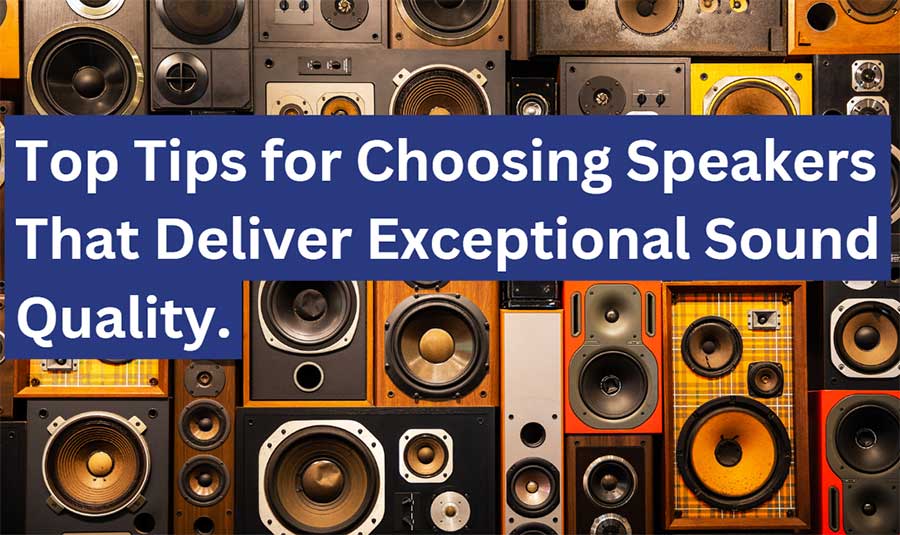How to Choose the Best Sounding Speakers: A Detailed Guide
When looking to purchase speakers, it’s easy to get lost in all the technical jargon and endless options. To help you make an informed decision, here’s a detailed breakdown of key considerations for choosing the best sounding speakers, tailored to your specific needs and preferences.
1. Identify Your Purpose
Your intended use for the speakers should guide your selection. Consider the following:
- Music Enthusiasts: If you’re focused on high-fidelity music playback, look for speakers known for their accuracy and balanced frequency response. You’ll want a speaker that doesn’t color the sound too much—meaning it reproduces music close to how the artist intended.
- Recommended: Bookshelf speakers or floor-standing speakers with high sensitivity ratings (above 85 dB) for clear, full-range sound.
- Home Theater Setup: For a cinematic experience, bass response and surround sound capabilities are critical. You’ll want speakers that offer rich, deep bass and clear dialogue. Adding a subwoofer will be key for achieving the low-end punch.
- Recommended: Tower speakers or a full surround sound system with a subwoofer.
- Portable Use: If you’re looking for speakers for outdoor use or portability, durability and battery life become essential. Opt for compact, wireless models with waterproof ratings.
- Recommended: Bluetooth speakers with IPX7 or higher (waterproof) and long battery life.
2. Speaker Type and Placement
Choosing the right type of speaker for your space and setup is crucial. Each type has its pros and cons:
- Bookshelf Speakers: Ideal for smaller rooms and desk setups, these speakers are compact but still capable of delivering a wide frequency range. Look for ones with a frequency response of 50 Hz to 20 kHz, which is standard for high-fidelity sound.
- Example: KEF Q350 – These bookshelf speakers provide crystal-clear highs, midrange accuracy, and decent bass, perfect for audiophiles with limited space.
- Floorstanding Speakers: These speakers are large and powerful, typically offering a more full-range sound. If you have the space and want a richer, more dynamic sound (great for movies and music), floorstanding speakers are the way to go.
- Example: Bowers & Wilkins 603 – These floorstanders provide deep bass and dynamic sound reproduction, perfect for home theater setups.
- Soundbars: If you’re setting up a home theater but have limited space, a soundbar paired with a wireless subwoofer could be a good option. Soundbars improve TV audio but typically don’t match the depth of a full speaker system.
- Example: Sonos Arc – A premium soundbar that supports Dolby Atmos, offering great sound for movies and TV shows with easy setup.
- Portable Bluetooth Speakers: If you’re after portability, look for wireless speakers with high battery life (around 10-20 hours) and good sound output despite their compact size.
- Example: JBL Charge 5 – Portable, rugged, and capable of delivering excellent bass for its size.
3. Sound Quality: Key Specifications
Sound quality is what really matters when it comes to choosing speakers. Here are the most important technical aspects to focus on:
- Frequency Response: This tells you the range of sound frequencies a speaker can reproduce, from the lowest bass (in Hz) to the highest treble (in kHz). A frequency range of 20 Hz to 20 kHz is ideal for full-range sound, covering all audible frequencies.
- Example: The Focal Chorus 726 has a frequency response of 39 Hz – 28 kHz, which offers deep bass and clear treble.
- Impedance: Measured in ohms (Ω), impedance affects how much power a speaker requires. Lower impedance speakers (e.g., 4 ohms) draw more power and can work with higher wattage amps, while 8-ohm speakers are standard for most home systems and tend to be more versatile.
- Example: If you use a high-powered amplifier, look for 4-6 ohm speakers like the Klipsch RP-600M bookshelf speakers.
- Sensitivity: This refers to how much sound a speaker produces for a given amount of power. Speakers with higher sensitivity (above 85 dB) are more efficient and deliver louder sound at lower power, which is important if you’re using a less powerful amplifier or receiver.
- Example: Polk Audio RTiA7 has a sensitivity of 90 dB, meaning it performs well even with lower-powered amps.
- Drivers and Speaker Configuration: The drivers are the components that produce sound. A woofer handles the low-end (bass), a mid-range driver covers the mids, and a tweeter handles the high frequencies.
- Example: Elac Debut 2.0 B6.2 has a dual woofer configuration and a soft-dome tweeter, which delivers balanced sound across the spectrum.
- Bass Response: Consider how low the bass can go. For richer, more immersive sound, especially in movies or music with deep bass (like hip-hop), opt for speakers with extended bass response down to 40 Hz or lower.
- Example: The SVS Prime Tower has a frequency response of 38 Hz to 25 kHz, providing tight bass with clear highs.
4. Wired vs. Wireless: Which Is Right for You?
- Wired Speakers: Generally, wired speakers offer the best sound quality with no risk of interference. They’re ideal if you have a dedicated audio setup and want the best sound fidelity.
- Example: A Yamaha A-S801 amplifier paired with Audioengine A5+ speakers offers robust sound quality for serious music listeners.
- Wireless Speakers: Bluetooth or Wi-Fi-connected speakers offer more convenience but may have lower sound fidelity due to compression or interference. However, premium wireless speakers often bridge the gap with high-quality audio and long battery life.
- Example: The Sonos Five is a high-quality wireless speaker with rich bass and clear midrange that works well in larger rooms.
5. Subwoofer Considerations
If you’re looking to enhance the low-end response (especially for home theater or bass-heavy music), a subwoofer can greatly improve the overall sound experience. Many floor-standing speakers and soundbars have built-in subwoofers, but a separate subwoofer allows for more control over the bass.
- Example: The SVS SB-2000 Pro Subwoofer delivers deep, controlled bass that complements floor-standing speakers like the Elac Debut 2.0 B6.2.
6. Budget and Value for Money
You don’t have to spend a fortune to get great sound. While audiophile-level speakers can be expensive, there are excellent mid-range options that provide incredible sound without breaking the bank. Focus on finding speakers that balance sound quality and features within your price range.
- Example: The Q Acoustics 3020i bookshelf speakers offer excellent sound at a budget-friendly price, with a clear midrange and balanced bass for a small or medium-sized room.
7. Personal Testing and Reviews
Finally, testing speakers in person at a store, or reading expert and user reviews, is essential to ensure you’re making the right decision. Pay attention to:
- Clarity and Detail: Does the speaker reproduce the finer details of music or dialogue without distortion at higher volumes?
- Bass Quality: Is the bass deep without being overpowering? Does it remain clean and not muddy?
- High-End Response: Are the highs sharp without being piercing? A good tweeter should provide clarity without harshness.
Conclusion
Choosing the best-sounding speakers comes down to balancing your budget, usage, and the technical aspects of sound quality. Whether you’re an audiophile or just looking for an upgrade to your TV’s sound, focus on specifications like frequency response, impedance, sensitivity, and bass capabilities. Test your options and prioritize the sound features that matter most to you. By considering these factors, you’ll be well on your way to finding speakers that will bring your audio experience to the next level.
#journosnews
#speakers
This article was rewritten by JournosNews.com based on verified reporting from trusted sources. The content has been independently reviewed, fact-checked, and edited for accuracy, neutrality, tone, and global readability in accordance with Google News and AdSense standards.
All opinions, quotes, or statements from contributors, experts, or sourced organizations do not necessarily reflect the views of JournosNews.com. JournosNews.com maintains full editorial independence from any external funders, sponsors, or organizations.
Stay informed with JournosNews.com — your trusted source for verified global reporting and in-depth analysis. Follow us on Google News, BlueSky, and X for real-time updates.













